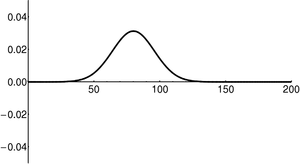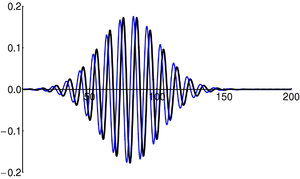Difference between revisions of "Quantum Mechanics"
KevinYager (talk | contribs) (→Schrödinger Equation) |
KevinYager (talk | contribs) (→Wavefunction) |
||
| Line 41: | Line 41: | ||
:<math> \psi(x) = \frac{1}{\sqrt{2 \pi}} \int \tilde{\psi}(k) e^{i k x } \mathrm{d}k </math> | :<math> \psi(x) = \frac{1}{\sqrt{2 \pi}} \int \tilde{\psi}(k) e^{i k x } \mathrm{d}k </math> | ||
:<math> \tilde{\psi}(k) = \frac{1}{\sqrt{2 \pi}} \int {\psi}(x) e^{-i k x } \mathrm{d}x </math> | :<math> \tilde{\psi}(k) = \frac{1}{\sqrt{2 \pi}} \int {\psi}(x) e^{-i k x } \mathrm{d}x </math> | ||
| + | |||
| + | {| class="wikitable" | ||
| + | |- | ||
| + | | [[Image:Free_packet2.png|300px]] | ||
| + | |- | ||
| + | | [[Image:Free_packet1.png|300px]] | ||
| + | |- | ||
| + | | Example of a 1D wavefunction (plotted versus 'x'). The upper panel shows the amplitude-squared, while the lower panel shows the corresponding wavefunction components: real (black line) and imaginary (blue line). | ||
| + | |} | ||
==State== | ==State== | ||
Revision as of 08:25, 13 October 2014
Quantum mechanics is a theory that describes the interactions of all particles and systems. It underlies all physical phenomena, including scattering.
Contents
Wavefunction
A quantum system is completely specified by its Wave Function:
| Integral Notation | Dirac Notation |
|---|---|
The wavefunction is typically normalized:
| Integral Notation | Dirac Notation |
|---|---|
The distribution of the particle described by is given by:
| Integral Notation | Dirac Notation |
|---|---|
In the Copenhagen Interpretation, is the probability of finding the particle at location . In Universal Wave Function interpretations (e.g. MWI), can be thought of as the spatial distribution of the particle. The wavefunction contains all the information one can know about a system. It can thus be thought of as 'being' the particle/system in question. However, the wavefunction can be described in an infinite number of different ways. That is, there is not a unique basis for describing the wavefunction. So, for instance, one can describe the wavefunction using position-space or momentum-space:
These representations can be inter-related (c.f. Fourier transform):
State
Note that the wavefunction describes the state of the system; there are various choices of basis one can use as an expansion.
A basis should be orthonormal:
| Integral Notation | Dirac Notation | |
|---|---|---|
| normalized | ||
| orthogonal |
An operator defines a particular convenient basis: one can always expand using the basis defined by an operator, in which case the above are the eigenvectors (or eigenstates) of that basis. This can also be viewed as a vector in the Hilbert space. The Dirac notation (bra-ket notation) is useful in this regard. A particular state is a (column) vector:
Which is a 'ket'. We define a 'bra' (the 'final state') as a (row) vector:
And note that the 'bra' is the conjuagte transpose of the 'ket':
Wave packet
TBD
Heisenberg Indeterminacy Relations
(Also known as Heisenberg Uncertainty Principle.)
Superposition
If and are both allowed states for a given system, then the following state is also allowed:
This leads to a notable consequence:
Notice that the final terms represent 'interference' between the two constituent states. This interference has no classical analogue; it is a quantum effect. Thus a superposition is not merely a 'joining' of the two states (e.g. "the particle can be in state 1 or state 2"), but a truly coherent interference between the two states. The superposition may be more generally written as:
| Integral Notation | Dirac Notation |
|---|---|
The distribution of the particle described by is given by:
| Integral Notation | Dirac Notation |
|---|---|
Operators
Observables in QM appears as operators ().
Examples: TBD.
Measurement
The transition of the wavefunction into state can be thought of as:
When acting on a wavefunction with operator the probability that the wavefunction ends up in state is given by:
The solutions take the form of an eigenvalue problem:
The allowed solutions of the equation, for operator , involve an eigenstate with associated eigenvalue . A measurement on a quantum system can be thought of as driving the wavefunction into an eigenstate defined by the operator; the value of the associated observable is then fixed to be the corresponding eigenvalue. (As noted above, the probability of ending up in a particular eigenstate is regulated by the coefficient of that eigenstate in the original wavefunction decomposition.)
Expectation value
A given operator, e.g. , implies an expectation value (for state ) of:
If the system is in an eigenstate of the operator:
We know that:
And so:
In other words, the expectation value of an eigenstate is simply the eigenvalue.
Schrödinger Equation
Time-independent equation
This simplified version of the Schrödinger equation can be used to solve for allowed stationary states. The general form is akin to the eigenvalue problems noted above: the energy operator () acts on the system state () to yield an energy eigenvalue ():
For a single non-relativistic particle, the Hamiltonian is known and the Schrödinger equation takes the form:
Time-dependent equation
More generally, the time-evolution of the wavefunction should be considered. The full version of the Schrödinger equation thus includes time dependence:
Again for a single non-relativistic particle, we can write more specifically that:
Entanglement
TBD
Decoherence
TBD


















































![{\displaystyle E\Psi (\mathbf {r} )=\left[{\frac {-\hbar ^{2}}{2m}}\nabla ^{2}+V(\mathbf {r} )\right]\Psi (\mathbf {r} )}](https://wikimedia.org/api/rest_v1/media/math/render/svg/c51f6b87a0560f7ad79de32ad673a62fa4e32cab)

![{\displaystyle i\hbar {\frac {\partial }{\partial t}}\Psi (\mathbf {r} ,t)=\left[{\frac {-\hbar ^{2}}{2\mu }}\nabla ^{2}+V(\mathbf {r} ,t)\right]\Psi (\mathbf {r} ,t)}](https://wikimedia.org/api/rest_v1/media/math/render/svg/f2ae69999ed8b8551b217b9fbdcd8bf73490c82f)